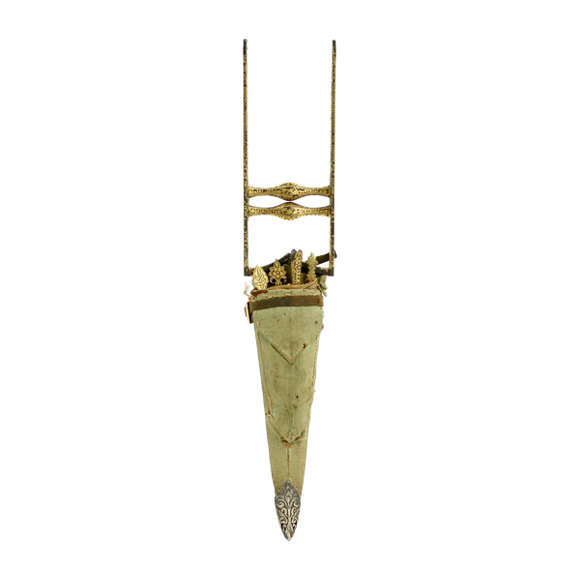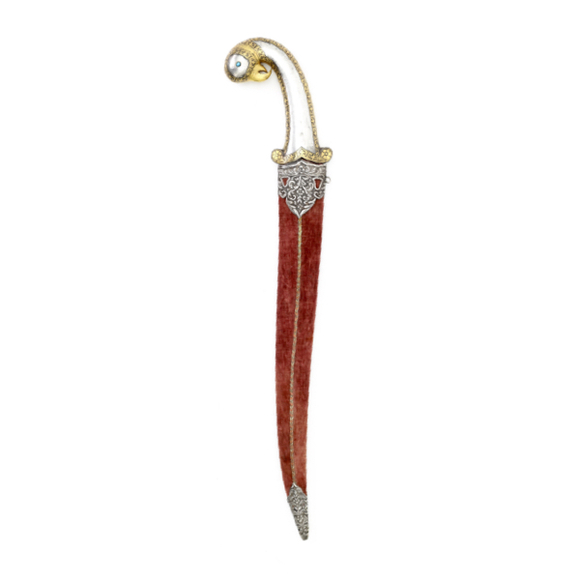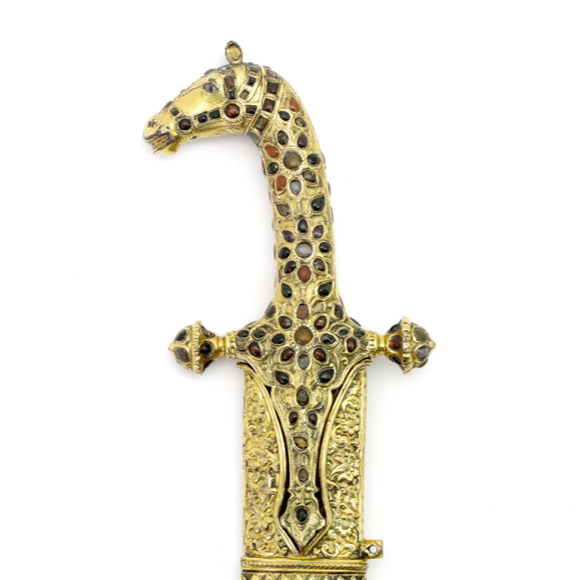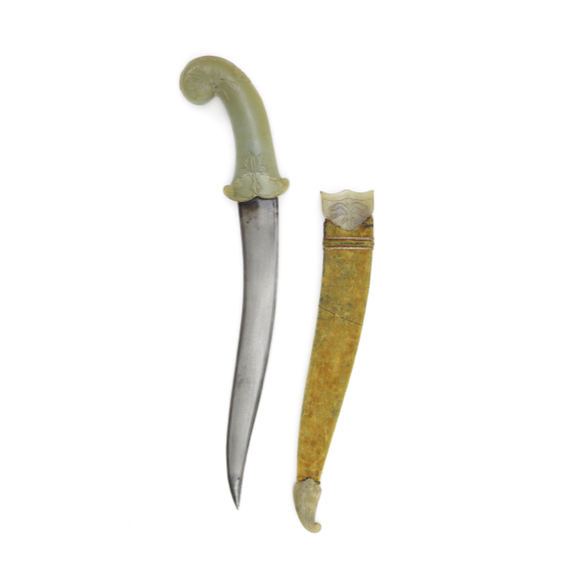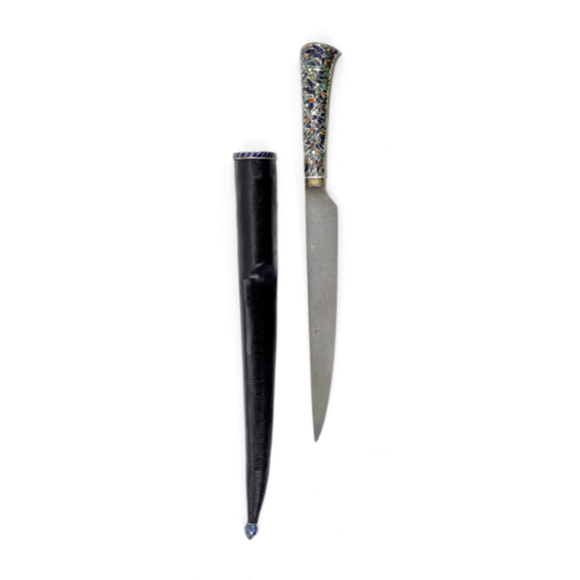By Harjit Singh Sagoo
(Antique examples added by Peter Dekker)
The Victoria and Albert Museum is home to a beautiful album from the early 1770s containing artwork providing an insight into the sports and hobbies of the nobility of that time (accession number: IS.25:23-1980). The album depicts a wide variety of physical activities in Mughal India. These include games like shatranj and chaupar, which are precursors to several popular board games in the West, such as chess and ludo. One particular page, however, would immediately draw the attention of martial arts and combat sports enthusiasts. That page portrays gatka fencing, dagger play, archery and wrestling. These four combat sports will be examined here.
Gatka fencing

The image above is a close-up depicting two Hindu or Muslim individuals engaged in a friendly duel with a farri (leather buckler) and gatka (leather-covered club) whilst another person raises a pata (gauntlet sword). Two other individuals look on, one smoking tobacco via a hookah (waterpipe). Since the early 20th century, these various martial exhibition skills are now collectively and commonly referred to as ‘gatka’ and has been claimed by Sikhs to be a ‘Sikh martial art.’ Historical sources, however, beg to differ.
Firstly, let us look at the word ‘gatka’ itself. It is in fact the name given to a leather-covered wooden stick or club (as pictured) simulating a sword. As per the Mahan Kosh encyclopaedia of Punjabi Sikh historian Bhai Kahan Singh Nabha (1861 – 1938), a gatka is a three-hand span stick. It is derived from the Persian word ‘khutka’ (club). Today, however, Sikh gatka practitioners refer to this club/stick as a soti (simply meaning ‘stick’ in Punjabi), while the entire exhibition art to which the stick belongs is called ‘gatka.’ The one they use is approximately a metre in length and of bamboo, ratan or plastic. There is no leather covering. It should also be stated that while Sikh scriptures, historical biographies and religious edicts contain numerous martial references, there is no mention of ‘gatka’, unlike ‘Dhanurveda’ (‘war science’, ‘archery science’). For example:
“Bedhang khat shaastar prabeena,
Dhanurabedh prabh ke rass leena.”
English translation:
“[The king Dalip] excelled in the Vedangas [limbs of the Vedas] and six Shaastras [compendiums],
He knew the essence of the Dhanurveda and the Lord.”
-Dasam Granth Sahib Ji, Brahma Avatar
Guru Gobind Singh Ji (1666 – 1708), the tenth Sikh guru, wrote fifty-two hukams (commandments) for Sikhs. The thirtieth commandment states:
“Study Shastar Vidya and horsemanship.”
Dhanurveda is a synonym of Shastar Vidya (‘weapons science’), the generic name of the actual Northern Indian battlefield art used by Sikhs, adopted from Hindu Rajputs. Its roots are ancient and legends trace its origins back to Lord Shiva, the founder of yoga (mind and body exercises), natyam (dance) and the martial sciences. All known historical artwork, including frescos and watercolours, depict only Muslims and Hindus demonstrating gatka, which is clearly for exhibition, not battle. A description of entertainers displaying gatka can be found in Volume 2 of the book, Hand-book of the Manufactures and Arts of the Punjab (1872), by English civil servant and forest conservator Baden Henry Baden-Powell (1841 – 1901):
“The ‘lakribaz’ [wood player] is also a performer of this class: he fights with the ‘gatka’ or basket-hilted singlestick, also with the ‘bank’ [baank], a huge two-handed straight bladed sword; or with the ‘saif’ or ‘phata’ [pata], a kind of broad-sword; he performs tricks also with the ‘maratti’ [marhati, also called a ‘baneti’], a bamboo pole with a lighted torch at either end.”
-Class 29: Implements Used in Trades and Occupations, page 309
The Ain-i-Akbari (‘Administration of Akbar’) of the Akbarnama (‘Book of Akbar’), authored by Abul Fazl (1551 – 1602), the court historian and chief secretary of Mughal Emperor Akbar (1542 – 1605), describes several classes of martial entertainers of the emperor’s court, one of which included Hindu or Muslim gatka players (from the 1873 English translation by German scholar Heinrich Blochmann, 1838 – 1878):
“There are several kinds of them, each performing astonishing feats. In fighting they shew much swiftness and agility, and join courage to skill in stooping down and rising up again. Some of them use shields [farri, bucklers] in fighting, others use cudgels [gatkas]. The latter are called Lakrait [wood players].”
-Volume 1, The Shamsherbaz, or Gladiators, page 252
In his book, The Journal of a Tour in India, 3rd edition (1858), Major-General Godfrey Charles Mundy’s description of gatka is like that of a playful martial game rather than a deadly battlefield art:
“The games were opened by the sword-players, who as well as the wrestlers, were entirely naked, with the exception of a cloth bound tightly round the waist, and reaching a few inches down the thighs… The first two combatants, who jumped simultaneously into the arena, were armed with a species of single-stick, shorter and heavier than those used in England, and covered with leather to qualify the effect of the blow; bearing in their left hands a small leathern buckler about the circumference of a dinner-plate. After a smiling salaam [Arabic for ‘greeting’; Sikh gatka players use the Persian term ‘fatehnama’], they approached each other very cautiously, circling round at the respectful distance of 10 feet, and using the most extraordinary and extravagant gestures — preliminaries which to me appeared absurd and unnecessary, but which an old Jemadar [officer] near me described as useful to awe and distract the attention of the antagonist, and to gain the sun of him. When they at last came to blows they laid about them in real earnest, striking with all their might, and often with both hands. The extreme dexterity which they displayed in warding with the little shield [i.e., farri], their crafty feints, and the immense springs they occasionally made to avoid or surprise their adversary, drew loud plaudits from the circle. Towards the end of the combat one of these supple fellows suddenly threw himself upon his knees, in order to cut at the legs of his opponent; and from that apparently helpless position, with the quickness of lightning, sprung back 6 or 8 feet to escape the stroke that was descending on his head [a move which gatka players call ‘chungi’]. The other, in attempting to retort the same manoeuvre, received a blow on the shoulder that echoed through the field; upon which, at a signal from the Subadar [Subedar, a chief, leader] directing the sports, the contending couple struck their swords and bucklers together, salaamed in token of amity, and swaggered out of the ring [modern Sikh gatka players too perform the fatehnama once again, sometimes ending with a Western handshake].”
-Chapter 9, pages 319-320
As already mentioned, the image above also depicts an individual raising a gauntlet sword. The typical skills used in displaying its use include circling the blade (usually a slightly flexible version) repeatedly in a figure-8 pattern (simply called ‘ghumauna’, meaning ‘spin’ or ‘twirl’) as well as slicing lemons or limes set upon the ground. Nowadays, fruit-cutting, especially whilst blindfolded, is a common crowd-pleasing gatka stunt. Pages 322-323 of The Journal of a Tour in India describes a player slicing lime:
“At the conclusion of the combats a man stepped forth to show us the practice of the double-edged [pata] sword, which in his hands appeared a terrible weapon, though in those unaccustomed to its use it is but an awkward instrument. The blade was full 5 feet long, and encumbered with a clumsy iron hilt reaching half way up the arm, like a gauntlet… a display of sundry sweeping and rotatory cuts… four small limes were placed on the ground, equidistant round the circle; and the fellow, describing a variety of twirling evolutions, not unlike an exaggerated waltz approached them alternately, and, without pausing in his giddy career, divided each of them in two with a well-aimed horizontal cut.”

 A patá with Solingen blade
A patá with Solingen blade
Sold by Mandarin Mansion in 2021
At some point during the British Raj (1858-1947), Sikhs adopted the martial games of Muslims which they, particularly Muslims of the Shia sect, would have displayed during their religious processions, namely Muharram and Ashura, which commemorates the martyrdom of Islamic figures Ali, Hussain and Hassan. An 1883 oil painting, also housed at the V&A Museum (accession number: IS.66-1885), depicts several Shia Muslim men during Muharram grasping a marhati. In the background, there is also a circular rope baneti, referred to as a chakri (‘wheel’) or vada chakar (‘big wheel’) by today’s Sikh gatka players.

Mohurrum in Calcutta
Victoria & Albert Museum accession number IS.66-1885
Another piece from 1860, painted in Benares, depicts Hindus performing the same martial display as the Shias during Muharram (accession number: 4674:6/(IS)). One of them wields a fire-lit marhati/baneti in one hand and a sword in the other. Two others skirmish with a buckler and gatka. Another, spins double tulwars (curved swords) as his teacher and other students look on, awaiting their turn.

Sword play, Benares, circa 1860.
Victoria and Albert Museum, 4674:6/(IS).
Sword play and sword dances have traditionally been referred to as ‘talvar-bazi’ or ‘shamshir-bazi’ (bazi simply means ‘play’ in Persian). A Pahari art style mural at the Burj mandir (Hindu temple) in Jammu, built in the 1800s depicts a farri-gatka duel. There does not, however, seem to be any art from the 19th century or earlier depicting Sikhs demonstrating the same skills. Today, the Hazara Shia Muslims of Pakistan can be seen demonstrating a fast and furious form of farri-gatka, along with the traditional Islamic kalaams (prayers) and salaams (greetings) related to their art. The skills are much more traditionally a part of their culture than anyone else’s. Please watch online videos of their performances. The Shastar Vidya battle skills of the Sikhs and Hindus are documented in ancient texts such as the Vasishta Dhanurveda and the four combat chapters (249-252) of the Agni Purana. There is a vast difference between Indian Shastar Vidya and the Persian/Indo-Persian gatka art. They are not synonymous.

A Marwari talwar with 1857 dated hilt.
Mandarin Mansion inventory 2024.

A fine horse-head shamshīr from Kutch, Gujarat. Late 18th to early 19th century.
Mandarin Mansion inventory 2024.
Khanjar-bazi, "dagger play"
Onto the next image. The image below depicts two individuals engaged in khanjar-bazi (dagger play) on the ground whilst four others spectate and converse/referee. The circle formed beneath them makes it apparent the players have been keeping within it as they strike and grapple.

Since the players are devoid of armour, the strikes would have been light and telegraphic so as to put on a good show for audiences, though deadly unarmoured weapon duels were not uncommon in India, as human blood sports such as Vajramushti (boxing with spiked knuckledusters) and Nakh-ki-kushti (wrestling with bladed claws) were prevalent, as reported by British soldier James Scurry (1766 – 1822) in his 1824 book, The Captivity, Sufferings, and Escape, of James Scurry and French traveller, writer and photographer Louis-Theophile Marie Rousselet (1845 – 1929) in his 1875 book, India and its Native Princes.
Their dagger skills would have been basic blows coming from various angles in different ways, such as tamacha (‘slap’) – a forehand strike; cheer (‘slice’) – a vertical forehand or backhand strike; bahera – a backhand strike; and hool – a forward thrust. The free hand would have been used for grabbing and parrying.

The daggers depicted resemble a type referred to as kapwah in Mughal literature.
Collectors today know them mainly as chilanum, after Egerton.
A very good example, Mandarin Mansion inventory 2024.
Archery
The image below depicts individuals engaged in forms of archery training. Note the individual using a cabled stone weight device to train and strengthen his bowstring draw. This device also appears in the Nujum al-Ulum ('Knowledge of the Stars’), a Persian-language compendium of Islamic and Hindu beliefs dealing primarily with astrology and magic (1570). Another individual can be seen shooting arrows from a kaman (composite bow) at a wheeled target box, while another seems to be slinging pebbles at a bird in flight using the divided bowstring of a longbow (a couple of pebbles are seen besides his left foot and one has just missed his target).

Wrestling
The last of the four martial sports on the album page depicts Indo-Persian pehlwani (wrestling). The individuals are shown performing dands (press-ups) and baithaks (squats), swinging a mudgar (club), assuming an advanced yoga pose (headstand padmasana), drawing a kabadeh (a heavy steel exercise bow), lifting a nal (circular stone weight), and, of course, engaging in wrestling itself. It is intriguing how the artist included some technical grappling moves instead of the most basic poses.

Conclusion
Historical art like this is an amazing window into the past. Much of these traditions were suppressed and forgotten due to deliberate purges of martial activities throughout the colonial era:
“From the earliest day of occupation the population was effectually disarmed, and heavy penalties attended the possession of an unlicensed weapon. Every fort was dismantled; the manufacture of powder, the importation of sulphur and saltpetre, were controlled. In the hour of peril the people found, that their fang had been drawn; they could not, even if they would, play with edge tools.”
-Robert Needham Cust;
Linguistic and Oriental Essays: Written from the Year 1846 to 1878.
Published 1880. Chapter 8, page 246.
“But ever since the war of 1857, Indians have been forcibly disarmed by the British. The manufacture of arms and ammunitions is exclusively controlled by the British. Even the military forces of the Indian princes are under the direct control of the British government. And the Indian soldiers in the British army are armed with inferior arms, and their movements are vigilantly watched by experts. I personally know of many soldiers who were and even today are severely punished for attending Indian patriotic meetings for the boycott of British goods.”
-The Washington Times
Sunday 16th April, 1922. Page 5
For the people of India and the Indian diaspora, such art can help them discover and reconnect with their martial heritage.
About the author
Harjit Singh Sagoo is a British multi-genre researcher and writer specialising the martial arts and traditions of the Hindu Kshatriyas and Sikh Nihangs. He has published articles and interviews in Black Belt magazine (USA), Martial Arts Illustrated (UK), Boevie Iskusstva (Ukraine), Asana Yoga Journal (India), Samurai Bushido magazine (Italy) and other publications. He is also the author of Shastra Vidya: The Ancient Indian Martial Art of the Hindu Kshatriyas and co-author of The Lost Warfare of India: An Illustrated Guide.


